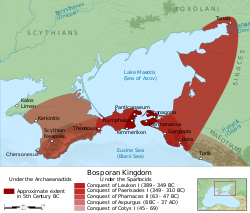Kingdom of the Cimmerian Bosporus Βασίλειον τοῦ Κιμμερικοῦ Βοσπόρου | |||||||||||||||
|---|---|---|---|---|---|---|---|---|---|---|---|---|---|---|---|
| c. 438 BC[1] – c. AD 527 | |||||||||||||||
 Map showing the early growth of the Bosporan Kingdom, before its annexation by Mithridates VI of Pontus. | |||||||||||||||
| Status |
| ||||||||||||||
| Capital | Panticapaeum | ||||||||||||||
| Common languages | |||||||||||||||
| Religion | Local variant of Hellenistic polytheism[2] | ||||||||||||||
| Government | Monarchy | ||||||||||||||
| King | |||||||||||||||
• 438–433 BC | Spartokos I | ||||||||||||||
• AD 314–341 | Rhescuporis VI | ||||||||||||||
| Historical era | Antiquity | ||||||||||||||
• Established | c. 438 BC[1] | ||||||||||||||
• Disestablished | c. AD 527 | ||||||||||||||
| Currency |
| ||||||||||||||
| |||||||||||||||
| Today part of | |||||||||||||||
The Bosporan Kingdom, also known as the Kingdom of the Cimmerian Bosporus (Ancient Greek: Βασιλεία τοῦ Κιμμερικοῦ Βοσπόρου, romanized: Basileía tou Kimmerikou Bospórou; Latin: Regnum Bospori), was an ancient Greco-Scythian state located in eastern Crimea and the Taman Peninsula on the shores of the Cimmerian Bosporus, centered in the present-day Strait of Kerch. It was the first truly 'Hellenistic' state, in the sense that a mixed population adopted the Greek language and civilization, under aristocratic consolidated leadership.[3] Under the Spartocid dynasty, the aristocracy of the kingdom adopted a double nature of presenting themselves as archons to Greek subjects and as kings to barbarians, which some historians consider unique in ancient history.[4] The Bosporan Kingdom became the longest surviving Roman client kingdom. The 1st and 2nd centuries AD saw a period of a new golden age of the Bosporan state. It was briefly incorporated as part of the Roman province of Moesia Inferior from AD 63 to 68 under Emperor Nero, before being restored as a Roman client kingdom. At the end of the 2nd century AD, King Sauromates II inflicted a critical defeat on the Scythians and included all the territories of the Crimean Peninsula in the structure of his state.
The prosperity of the Bosporan Kingdom was based on the export of wheat, fish and slaves. As a result, the Kingdom became the economic center of the Black Sea and is often dubbed the ancient Jewel of the Black Sea.[5] The profit of the trade supported a class whose conspicuous wealth is still visible from newly discovered archaeological finds, excavated, often illegally, from numerous burial barrows known as kurgans. The once-thriving cities of the Bosporus left extensive architectural and sculptural remains, while the kurgans continue to yield spectacular Greco-Sarmatian objects, the best examples of which are now preserved in the Hermitage Museum in St. Petersburg. These include gold work, vases imported from Athens, coarse terracottas, textile fragments, and specimens of carpentry and marquetry.
- ^ Hind, John. "The Bosporan Kingdom". In Lewis, D. M.; Boardman, J.; Hornblower, S.; Ostwald, M. (eds.). The Cambridge Ancient History. Vol. VI - The 4th Century BC. Cambridge: CUP. pp. 476–511.
- ^ Cite error: The named reference
Bryn1was invoked but never defined (see the help page). - ^ Kozlovskaya, Valeriya (2017). The Northern Black Sea in Antiquity. Cambridge University Press. p. 173.
- ^ Moreno, Alfonso (2007). Feeding the Democracy: The Athenian Grain Supply in the Fifth and Fourth Centuries BC. Oxford University Press. p. 168.
- ^ "How the Bosporan Kingdom Became the Jewel of the Black Sea". 26 December 2018.